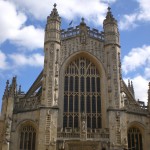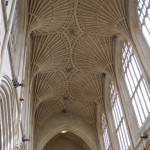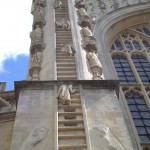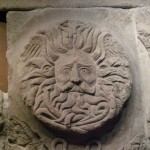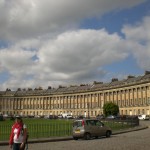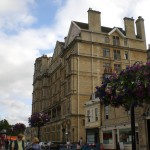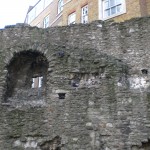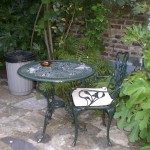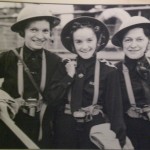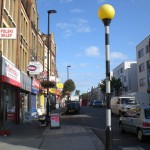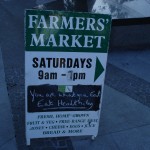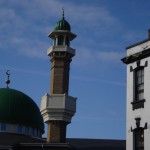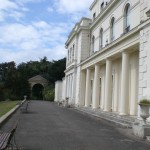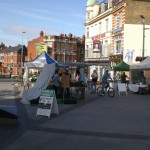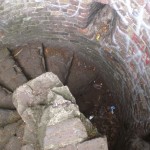Entries Tagged as 'Grace'
August 29th, 2009 · 1 Comment
Today we wandered, via the scenic route, over to the Victoria and Albert Museum in South Kensington. We knew that it would be an eclectic and eccentric collection, but we were in for a surprise…
Upon exiting the convient tunnel linking the Tube to several well-visited museums and sites in the area, we found ourselves in a ground floor sculpture hall. Randomly picking a direction to walk in, we wandered into in the fashion section. (Aidan and Brandon were thrilled.) In this collection we found everything from hautecouture to Elizabethan-era ensembles. Some of these clothes were truly shocking! One such item reminded Kelley of a woolly mammoth, but alas, it was a apres ski jacket. While we were lingering by a shirt made from a parachute and some heavily-sequined items, we could see into an exhibit of Raphael’s cartoons.
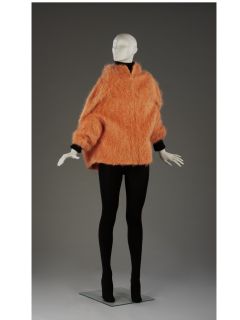
The Woolly Mammoth, erm, Apres Ski Jacket (picture taken from the website of the Victoria and Albert Museum)
A cartoon is a preliminary drawing for either a tapestry or a painting. In this case, the drawings were for a series of tapestries commissioned for Pope Leo X and they depicted a number of scenes from the Bible. We were impressed with the sheer size and careful preservation of the drawings. As one of the completed tapestries was present, it was also interesting to see what the finished product looked like.
We decided simply to wander from exhibit to exhibit in order to understand the Victoria and Albert collection as a whole. We were met with limited success. While the museum contains an extensive array of artifacts from around the globe, we found that there was no logical flow pattern in the museum. For example, we went from Korea to the European Cast Court (essentially a large number of copies of well-known facades and memorials) and again from finely-painted late 19th century tables to the radios of the 20th century. Essentially, we were confused. Why were these objects here and what is the purpose of their order? What is the collection of the Victoria and Albert trying to say to the visitor? It reminded Grace of a really nice yard sale. To Kelley, it was like searching around her grandparent’s basement. We found the artifacts to be very interesting and laid out well within their exhibits,we just question the museum’s purpose as a whole. That said, it was a worthwhile way to spend an afternoon. (We highly recommend going out into the garden and watching the children playing in the paddling pool!)
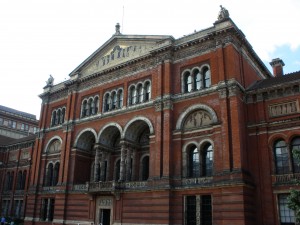
The architecture of the V&A from the garden
Tags: Grace · Kelley · Museums · Uncategorized
I can honestly say that the day trip to Stonehenge and Bath was one of the best days of my life. First of all, the weather was fantastic and most of my great days start with great weather. Stonehenge was impressive, and I am truly thankful that we were able to visit, but I’m glad it was only allotted one hour of our time. I was really looking forward to the town of Bath, the home of an extremely well preserved Roman Bathhouse, beautiful Georgian architecture and yet another gorgeous Gothic Abbey. As our bus was winding up and around narrow country roads (and I was praying we didn’t run off them) the town came into view. My jaw dropped. In front of me was what appeared to be the quintessentially English country town…. Complete with Jane Austen! Lunch at the Rat and Parrot pub seemed like a good sign, I’ve never been called “dearie” and “love” more times in an hour than I was there. Walking through the bathhouse with my audio guide I learned about the history of the baths and the bathhouse culture of the Romans. While the museum commentary was informative, I ended up listening to Bill Bryson’s commentary rather than the museum. Bryson has a way of making the simplest truth hilarious. Perhaps it’s the way he phrases things, or maybe it’s the delivery. I still don’t know but I was laughing (and, of course learning) the whole time. The case dedicated to the ‘curses’ was especially hilarious. These little tablets were thrown into the waters as an offering to Minerva in hopes that she would grant what they wished. My favorite was the one about the missing cloak, in which the writer wishes all sorts of injury and ill luck upon the man who robbed him. How could this advanced society, this mighty empire, believe that inscribed tablets to the Gods would help them find their misplaces items? These little curses reminded me of Elementary school threats and superstitions… empty and irrational. “Step on a crack and you’ll break your mother’s back!” although, as a first grader it took me weeks to get over that one. The rest of the day was spent admiring the wonderful Georgian architecture and the Bath Abbey. Just as professor Qualls said, the fan-vaulted ceiling was incredible. The amount of detail that is used in a Gothic church always floors me. I don’t think I would have had the patience to complete it. Some of the most interesting elements were the climbing angel sculptures on the towers. I suppose they are meant to be climbing to heaven. I wanted to climb up there to see a better view of the whole town. I would go back to Bath in a heartbeat, anyone up for a weekend trip when we have time?
From one end of the spectrum to the other… the Tate Modern is the sister museum to the Tate Britain, which houses more ‘traditional’ art on the other side of the river. This old factory and warehouse has certainly retained its origins. The minute you walk in you are overpowered by the sheer space. It’s absolutely huge! Although now that I think about it, it is better to have all that empty space from the ground floor to the ceiling for a large instillation or sculpture. Because of time constraints, I was only able to explore one floor of exhibits. But within those two exhibits I was able to satisfy at small part of my quest to find Modern, British art. What do you think of when you think of British art? I always thought of Gainsboro’s portraits of upper class women in their taffeta gowns against a sweeping background of forest of meadows. Until yesterday I could count the number of British artists I had studied in a Dickinson art history class on my fingers. I was able to see some of my favorites in the abstract expressionism gallery. Kirchner and his take on the classic bathers motif (but with garish coloring and hash angles), Matisse and his simple yet powerful paper cutouts, and Lee Krasner’s Gothic Landscapes. When you research Lee Krasner after reading this, (I am sure most of you have never heard of her) please remember to view her art as a separate entity from her husband’s art…. She was a well-established artist in her own right before they were married. But back to the question, what does the art of a Modern Britain look like? I found a few answers in the Surrealism exhibit. Surrealism is fascinating to me. Not only does it explore the role of the subconscious and dreams, the art tends to pair opposite themes and emotions. Whimsy. Violence. Dark. Light. Primitive. Advanced. My first new artist was Roland Penrose. His piece, Portrait (1937) is a mix of words and images that pushed the boundaries of “acceptable” art out the window. Higher-ups who thought the word “arse” was too foul to use in art removed this piece from display. Little did they know that another one of his pieces used sign language to spell out the word “SHIT.” As I moved in to the Realism section I came into contact with several more new names. Margurite Kelsey, Stanley Spencer and Maraude Gueruarva all painted around 1930. The pieces in the Tate Modern all possess an element of mystery. Kelsey uses such fantastic lighting in her work and the style is almost academic, but at the same time thoroughly modern. Cornelia Parker’s instillation, Thirty Pieces of Silver (1988-9) was my favorite piece of the day. The artists had collected silver object, anything ranging form a teaspoon to a trombone and then had then all rolled over by a steamroller. Most of the items were flattened into wafer-thin version of their original shapes. She then arranged the new forms into disks suspended to the ceiling by thin wire. The effect is almost other-worldly. Looking across the room your eye gets lost in the maze of spider silk like threads sprouting from the ceiling. You follow the threads to the floor and “floating” directly above it– the silver disks. Not only are the disks themselves beautiful to look at, the shadows they cast creates an entirely separate work. I tried to look at the shadows and guess what the object above it was. Sometimes I could tell, other times, not so much. The only thing that could have made this instillation better would be the ability to walk all the way around it. At this time you are limited to two sides. Maybe this is how Parker imagined the instillation… Maybe I can try to find a suggestion box next time I am there.


So what is Modern British art? I don’t know that I have seen enough of a range to give you an answer. I can say that yesterday was an education and an experience. I hope to return to the Tate Modern when I have four or five free hours. I’ll call this the beginning of my quest. What do you think? My time here in London is flying by and each day leads me to see or try something new. I am so thankful for this opportunity.
Tags: Grace

The Tympanum
It’s amazing how much our group has accomplished within one week, and how much we manage to pack into each day. Today was no different in that respect. We walked down towards Westminster Abbey from Trafalgar Square at 9am. When Westminster came into view, I found myself staring up at one of the most beautiful Gothic churches I have ever seen. Everything from the tympanum (recessed triangular space over a door between the lintel and the arch) to the immense flying buttresses to the highest nave in Great Britain was elegant and stately. We met our tour guide, John, and he immediately began to educate us on the Abbey’s impressive history. Westminster Abbey, or the Collegiate Church of St. Peter in Westminster, was first built in 1042 during the reign of Edward the Confessor. The Abbey in existence today was built around 1216 during the reign of King Henry III. Henry wanted a place where he could be buried, where his ancestors could be crowned and a place dedicated to the piety of Edward the Confessor.
Westminster is the final resting place of over three thousand people, from Queen “Bloody Mary” to Charles Darwin. However, among the many Kings and Queens the grave that I admired most belonged to the Unknown Warrior. The man who lies in that grave gave his life for England and that spot has come to be the place of mourning for all who lost someone during World War I. The Unknown Warrior was retrieved from a battlefield in Northern France and was placed in the Abbey in 1920. He was posthumously awarded both the Victoria Cross and the Congressional Medal of Honor. Unlike the other graves that lie under the stones of Westminster, no one is allowed to walk over the grave of the Unknown Warrior. Coming from a family with a strong military background, I have a great deal of respect for all that serve in the armed forces and give their lives to protect their country. The treatment of the Unknown Warrior tells me that I share this trait with the people of Britain. Walking through the nave and the individual chapels is like stepping back into time. The graves of the House of Tudor were especially impressive. The Henry VII chapel’s contains the largest collection of Tudor statues and is also the mother church of the distinguished Order of the Bath. The united roses of Lancaster and York were also prominently featured in this section. I thoroughly enjoyed my visit to Westminster and I would definitely like to go back for an Evensong service to hear the choir.

View from the bathing hut at the Miami Beach Surf Club (1946)
After a comical lunch at an Italian restaurant, a few of us went to the Churchill Museum and Cabinet War Rooms. I was really looking forward to this site because I love World War II military history and Churchill has always been such a mythic figure in my mind that I wanted to learn more about his life. First of all, I now understand why he often went to the rooftops to watch the German planes bomb the city… I couldn’t stand being cooped up underground for such a long time. I think I would go mad if I couldn’t see the sky or feel fresh air on my face. The Museum was a combination of a tour of the underground bunker and an exhibit on the life of Sir Winston Churchill. I leaned some more intimate details about the man behind the cigar. For example, he loved his velvet ‘romper’ suits, the pet name he used for his wife Clementine was ‘Kat,’ and he always took an afternoon nap at 6pm. The one piece of information that really caught me by surprise was Churchill’s love of painting. He said that painting helped him through his bouts of depression, what he called his “black dogs” or “brown days.” His work is mostly landscape and is reminiscent of early modern painters, like Cezanne. I never would have guessed that this wartime PM and “bulldog” would have such a hobby…Shame on me for jumping to conclusions. He often painted while he was abroad in between his scheduled meetings. I can understand why Churchill is idolized in British history, his strong personality and leadership helped boost morale amongst soldiers on the battlefields and citizens on the home front. Undoubtedly, the resilience and determination of the people living through the Blitz was Britain’s “finest hour.”

Today was full of new experiences for me. Walking through Westminster Abbey took me through thousands of years of history and power, and the Cabinet War Rooms reminded me of the importance of a strong leader in troubled times. London constantly reminds us of Britain’s strong military history in its public squares, monuments and churches. Throughout the city ‘War’ and ‘Peace’ coexist. The Unknown Warrior has found peace for an entire nation within the walls of the Abbey and Churchill’s annex can remain frozen in time as a reminder of the cost of war.
Tags: Grace · Uncategorized
August 25th, 2009 · 1 Comment
After a delightful performance by E.L.F. trio in St. Martin in-the-Fields, I walked over to the National Gallery with some classmates. I was about to enter a museum with one of the most extensive collections of artwork from the 13th to early 20th centuries, and I was in heaven. As an art history major, art museums, especially one as large as this one, make me feel like a kid in a candy store. Our group made a plan to meet up at 4pm and so Kelley and I headed off to the Sainsbury Wing to investigate paintings from the 13th to 15th century. Although I prefer modern art, I found the works in this section very moving. Of course, they all had a Christian connotation and most of them were placed in a church at one time as an altarpiece or as part of a triptych. As a Reform Jew, I really don’t know much about Christianity outside of the Old Testament; however, everyone can appreciate the beauty of these paintings and the emotions they evoke. After passing through room after room of the Virgin Mary and Christ I began to wonder, why is the Virgin always depicted in blue robes? The blue is a similar shade in every painting, somewhere in between the color of a clear sky at dusk and a robin’s egg. Naturally, I looked it up when I returned to the Arran House. Some of the answers I found ranged from the ridiculous “because it’s her favorite color” to the more academic explanation, “blue was the color Byzantine empresses wore.” All I can say is that the particular shade of blue is a color I’ve only ever seen in these paintings, so I guess I’ll leave it as ‘the Virgin Blue.’
As we moved through the rest of the museum I was overcome with joy… I was seeing some of my favorite lessons come to life. When you see a picture that you study in your textbook or in a slide comes to life, it’s like seeing it for the first time all over again. Major players like Masaccio, Titian, Raphael and Bellini were all here. It was hard for me to believe that I was actually standing in front of THE Aronlfini Wedding Portrait by Jan van Eyck. This paining first began my love affair with the Dutch school of painters and semiotics…. now I was here, in front of it. I could actually see the dog (for fidelity), the removed shoes (the marriage as a religious sacrament), and the reflection of Van Eyck himself in the mirror along with the inscription “van Eyck was here.” Also, for anyone who is interested, his bride is NOT pregnant. She is simply wearing the style of dress that was popular at this time period. I was even able to see Holbein’s The Ambassadors (1533) and walk across the room to see the anamorphic perspective skull.
However, when I walked into the 19th and early 20th century gallery my heart really began to race. As Kelly will attest, I did audibly gasp when I saw Gauguin’s Still Life with Mangoes (1891-6). This section was by far my favorite. The late nineteenth century painters were the first school to paint modernity; they disregarded all the set rules, added some color and painted the world around them rather than the bible or portraits. Degas, van Gogh, Cezanne, each one brought paining to a new place either with subject matter, texture or color. The Degas gallery was especially moving. I am fascinated with his series that captures the private movements in women’s lives. He takes everyday scenes intimate such as a woman drying herself off after a bath or having her hair combed and turns it into a story for the viewer. We are left wondering, who is she? What is she doing? Why?
Of course, I could not make it through the entire gallery in one day. So I plan on returning soon to take in the 17th century (including one of my absolute favorites, Vermeer) and to revisit the early-modern painters. Everyone should visit the National Gallery, regardless of his or her “art background.” It really is the crown jewel in the world of art museums. I anyone wants to come back with me, please let me know.
Tags: Grace · Museums
What I love about our walking tours is the complete sensory overload that occurs when we set off up and down the streets. Of course, the visual stimuli are wonderful, The Roman Wall, the Tower of London … I could go on and on. But the great thing is that it’s not just visuals. On market day I was able to indulge in the delicate spices wafting through the air from the many food vendors at Acton Market. Also, this entire journey has been made even more enjoyable by the wide selection of tastes I have enjoyed… Wensleydale cheese, Aloo Kachori, Sheppard’s Pie. Yesterday on my Bloomsbury tour I was able to hear some different sounds than I was used to. When we walked past Coram’s Fields I heard the laughter of children and the whooshing of a zip-line inside the playground. This was the complete opposite the church bells pealing and the traffic rushing by that I heard on the Roman Wall tour earlier that morning. The tube is another story altogether. The Brits who ride the underground are silent…. Another one of their “privacy rules” I’ve noticed. If people are talking it’s in another language or it’s one of my classmates. Listening to other languages as I wander around has really made me appreciate London as a global city. Where else can you walk down a side street and hear one man talking in rapid Portuguese on his mobile and hear a woman speaking to her daughter in Farsi within two blocks of each other? My trip out to West India Quay this afternoon only increased my interest in the sounds of this great city.
The Docklands Museum provides a wonderful time line of life by the Thames from pre-Londinium to the present day. In considering London the ultimate melting pot of humanity, this museum manages to incorporate many of the major events of the Docklands history in its three floors. I enjoyed many of the interactive aspects of the museum such as the touch screen information panels, the dark sailor’s alleyway (thanks for going first Brandon!), and the spice boxes. However what really struck me were the audio aids. At every exhibit you were bombarded with snippets of sounds that perfectly blended with the content of the prompts and the visuals. Like many of my classmates, the exhibit on the evolution of slavery in England made a major impact on me. The audio and video that accompanied this section was powerful, arresting and disturbing. I can tell you that the words will stay with me for a long time. As I walked around reading about the Middle Passage, Caribbean plantations and the struggle for Abolition, “YOU WILL BE BEATEN, YOUR CHILDREN WILL BE TAKEN AWAY FROM YOU, YOU WILL LOSE YOUR FREEDOM” kept ringing in my ears. Once I reached the exhibit on the London Blitz, the whispered and paranoid tones of “ Keep it under your hat” and “Loose lips sink ships” had me looking over my shoulder to make sure I was alone.
Take each small moment and observe what is going on around you. At lunch I heard opera music drifting into the back garden, I heard the fire alarm 20 minuets ago, A dog is barking outside right now. Each day I spend here gives me another opportunity to “listen in” and lean about the city of London. I encourage everyone to look up when you walk around, open your window, sit out in the garden, go to a park or a pub.
I read this poem at The Docklands Museum and it immediately made me think of this course.
“The London Breed” by Benjamin Zephaniash (1996)
‘I Love this great polluted place
Where pop stars come to live their dreams
Here ravers come for drum and bass
And politicians plan their schemes,
The music of the world is here
This city can play any song
They come to here form everywhere
Tis they that made this city strong.
A World of food displayed on streets
Where all the world can come a dine
On meals that end with bitter sweets
And cultures melt and intertwine
Two hundred languages give voice
To fifteen thousand changing years
And all religions can rejoice
With exiled soul and pioneers
It’s so cool when the heat is on
And when it’s cool it’s wicked
We just keep melting into one
Just like the tribes before us did
I love this concrete jungle still
With all its sirens and its speed
The people here united will
Create a kind of London breed.’
Tags: Grace · Museums
We departed the Arran Hotel at 8:20 and walked to Goodge Street Station. We took Northern Line to Leicester Square and arrived there at about 8:30 and then transfered to Piccadilly Line. After traveling through tunnels and above ground we arrived at Acton Town at 9:02. After studying the map we realized that we needed directions from a local. The first candidate that we spotted appeared normal but unfortunately she shunned us with a 10 Commandment display that hanged around her neck and simply said “No!” The next person we asked was a man who looked like he belonged in a “Just for Men” commercial due to the reddish tinge of his mustache which did not have any resemblance to his natural hair color. Despite his appearance he ended up being very helpful and gave us the proper directions.
After passing through what looked like a residential area we arrived at the market ten minutes later. We were a bit surprised by the lack of action taking place in the central market area. We walked up and down the market area observing each stand. We then had the pleasure of meeting Vanessa who was the market supervisor. Since we had our notebooks and cameras out she inquired as to whether we were reporters writing an article. We explained to her that we were college students exploring London markets and she notified us that many local residents are on a holiday and that it would be a quiet day at the market. Under the temptation of the delicious food scents wafting through the air we contemplated eating an early 10 AM lunch. While we were pondering, a curious old bloke with beer dripping down his chin told Henry that he was lucky to have two girls with him. After Henry nodded his head in agreement the man proceeded to ask us if we were from “down undah.” Sharing our heads profusely we articulated that we were in fact Americans. Immediately upon hearing this he rallied off a series of questions mentioning our change in government. After responding to his inquiries we got out of the market swiftly and decided to explore the surrounding area.
As we wandered up and down the nearby streets we noticed a growing Muslim population as evidenced by the new Mosque, the Library for Iranian Studies and multitude of restaurants that served Halal options. Part of the reason why the market place was empty was due to today being the first day of Ramadan. Acton struck us as a tight knit community that was not used to having people come and actively spend time within its town limits. That being said most everyone was friendly and greeted us with a smile. After scanning all the stands which included West Indian, free range sausages, fruit and vegetable stands, spit-roast BBQ, tapas, cheese and bread, and Afro-Caribbean cuisine we decided on South Asian. We indulged in chicken dishes, Aloo Katchori and black tea with milk. While we were eating we enjoyed Bob Marley tunes playing in the background.
Upon leaving Acton Market we decided it would be a good idea to make our way towards Gunnersbury Park to observe and absorb the sights and sounds of the day. As we ventured through the crumbling brick outer courtyard we came upon a large, white building that simply said “Museum.” We entered and began to explore the inside of the mansion that once belonged to a family in the Victorian Era. After exploring the extensive gardens we discovered Princess Amelia’s bathhouse, a greenhouse, and the remains of a turret. After wondering what life would be like as Princess Amelia we headed back to the Acton Town station and made our way back to the hotel. We arrived at the hotel at 13:15. We probably won’t make our way back to Acton Town. This was not because we disliked it but because it is not a type of place people would actively seek out.
Tags: Grace · Henry · Jeyla · Markets
We began our tour this morning on a ferry ride along the Thames River. I was a bit confused by the general docking and disembarking procedures… backing up 20 feet to leave? what? We arrived in Greenwich early enough to beat the crowd to the Prime Meridian. Although I remember learning about this in middle school, to actually see it made it “real”… So this is where everything starts… We were then allowed enough time to explore the museum and I think my favorite part was the Christopher Wren octagonal room on the upper level. The dome was so intricately carved, yet the rest of the room was simple. The tall windows, which encircled the room, all provided incredible views. On one of the walls two portraits of Charles II, the reining king at the time, stare down at you. Maybe this is just my observation, but I think there is something effeminate in the Stuart line of kings that I never see in any other portraits of royal British males… thoughts? I also really liked the working telescope at the top of the building and the exhibit just below it that questioned our human concept of time and its importance. However, the tight spiral did scare me a bit. I always wanted to have a spiral staircase in my home. This experience has swayed me.
After a delightful lunch at the Admiral Hardy, Aiden, Henry, Brandon and I set off for the National Maritime Museum. Although I found this museum interesting, some of the exhibits were a bit disappointing. I had high hopes for “Art and the Sea,” but depictions of the Royal Navy conquering all others can only stay interesting for so long. At least there was one contemporary painting tucked away in the last corner of the room. I was expecting the “Passengers” exhibit to relate more to our course and show some of the experiences of immigrating to Britain by sea. Instead, this was more like an advertisement for cruise ships. Although, it did have a few Titanic and Lusitania relics. Of course there were boat models everywhere! In all different shapes, sizes and purposes. From the Museum we headed to the Old Royal Naval College Chapel. Along the way we stopped in the Painted Hall. It was incredible! I have never sen so much Trompe l’oeil in my life! The Chapel was amazing and the way the ceiling was arched made the acoustics of the building near perfect… I only wish I could have heard some of the Trinity College music students performing in there to get the full experience. Our group decided to walk under the Thames to take the DLR train back to the tube. The walk underground was cool (temperature wise) and relatively quick. Once we got on the train it was smooth sailing (or, riding) all the way back to the Arran House. I would have liked to see the Market, but at least I have an excuse to go back and wander the streets of Greenwich.
Tags: Grace · Museums
Starting our first of what’s bound to be many exhausting days, Team Grace Kelley journeyed to the far-away land of Piccadilly Circus via the Tube. We found the Tube to be easy, efficient, and foolproof. Our trek began at Goodge Street Station and took us to our transfer point at Leicester Square and on to Piccadilly. When we got off the train, we followed the clearly marked “Way Out” signs, right into the tourist heart of London. In front of us was a fountain and statue of Eros, commemorating Antony Ashley Cooper, Seventh Earl of Shaftesbury, for his philanthropic work. The monument was surrounded by tourists of every shape and size! As we wandered around the statue and the area, we heard at least six or seven different languages. People were taking pictures on the stairs of the statue and the Ripley’s Believe It or Not employees were “performing” for the tourists.
One of the more noticeable features of the Circus, or circle, was the juxtaposition between the Regency style architecture and the neon/plasma screen advertisements on the sides of the buildings. The Regency style uses a lot of white stone facades and vertical lines. This style was first implemented by John Nash and inspired interior decoration, as well as fashion trends (ex. pier waistline for women). It includes an abundance of rod-iron balconies and windows and uses symmetrical shapes, having similar elements to the Georgian style of architecture.
Piccadilly Circus, established in 1819, was named for Pickadilly Hall, the residence of a famous tailor who was known for selling the piccadills-style collar. Its central location in the City of Westminster makes it an ideal meeting spot and one of the most well-known places in London. Here tour buses, the Underground, and city buses converge at a fast pace onto the crowded streets. However, we encourage walking and found it a very easy journey back to the Arran House.
Piccadilly Circus is a tourist trap, but it one worth seeing… watch out for pickpockets!



Tags: Grace · Kelley



